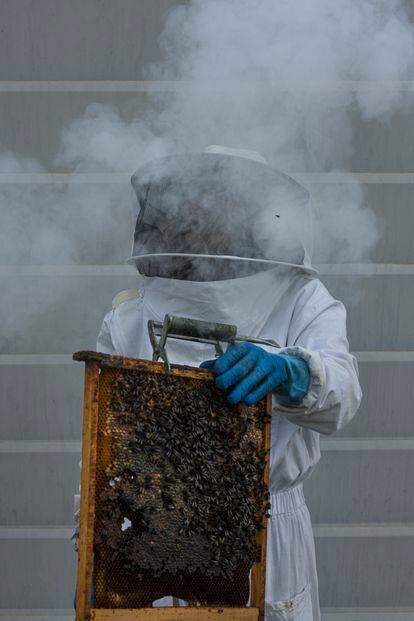The bees are dying, environmentalists warn, but in the Valencian restaurant Lienzo they are more alive than ever.
The one that sits on the first starter of the menu created by María José Martínez is made with orange blossom honey that she collects together with her father from the family honeycombs in Alhama de Murcia, her birthplace.
It is the same one that she "gobbled up" when she was little.
A food of great sentimental value for the cook that she has turned into the common thread of the gastronomic proposal of the place that she runs together with her partner, Juanjo Soria, and that last December received its first Michelin star.
Both have spent seven years consolidating a discourse that speaks of the earth, the one they step on now and the one from their childhood.
“Here you can't find oysters or
foie gras
.
You can't find a pigeon.
We go against the current of what would be a classic gastronomy and we do what we want”, summarizes Martínez, 37 years old.
His idyll with honey goes back a long way, but it was four years ago when he decided that he was going to stop having just a little wink in the
petit fours
—miniature sweets served with coffee— to become the centerpiece of his kitchen, where he is not just an ingredient.
It is a piece of honeycomb that is chewed like gum at the end of the meal, just as she did when she was little.
It is a shrimp cooked in beeswax or a pumpkin cooked in honey.
She wants people to "think", to become "aware".
Show the full potential of bees, their value for environmental biodiversity, and support a beekeeping sector hit by the consequences of climate change, monocultures, the proliferation of invasive species and the importation of low-quality varieties at little cost.
“Honey is much more expensive than sugar.
A really good one can cost you six euros per kilo, how much does sugar cost you?
Dessert made with honey from the urban beehives of Valencia.
Raul Belinchon
The honey that she uses in her dishes comes from the family hives, but also from Ayora, in Valencia, and even from just a few meters away.
From her restaurant, in the Plaza de Tetuán, to the Jardines de Viveros, it is just a 10-minute walk across the old Turia riverbed.
There, on the roof of the Valencia Municipal Tree Observatory, dozens of bees flutter around several urban hives.
The project, born in 2015 with an informative spirit, is distributed in four different points of the city and thanks to it, about 40 kilos of honey are collected each year with different characteristics depending on the location: rosemary, with more tree sap than nectar, or milflores, like the one that Martínez uses in the dessert that closes his menu.
In his efforts to give it the value he believes it deserves, Martínez has even ended up substituting all the sugar for the natural sweetener.
“The first sweet taste that a human being tasted in the world was fruit and the second was honey.
Sugar cane was something that came much later.
For me it is like going back to the very beginning”, he reflects.
Orange blossom, for example, is perfect for sweet and salty contrasts due to its subtle and discreet flavor, while honeydew —created from tree sap— lends itself to replacing sugars transformed into sorbets and ice creams.
She also uses it to brew craft beer.
Since she was a child, Martínez has had contact with beekeeping thanks to the family hives in Alhama de Murcia, her birthplace.
Raul Belinchon
Canvas, which occupies the site of a former art gallery, was not always a gastronomic restaurant.
It began as a signature tapas bar until Martínez and Soria realized that they had "a lot to tell" and that cooking was the means, the way to talk about "sustainability" and "the territory", because all the products that they use are local and ecological.
Eel, collaret peanut, shrimp from Santa Pola, mullet roe, pilpil made with tiger nut and national pine nut.
And with each one of them, again, the defense of ways of life, of a way of understanding consumption and food.
“Now you go to a pastry shop and you find things with thousands of pine nuts and you say how this is possible.
I buy the national pine nut at 100 euros per kilo, but it is giving work to people from here,
Martínez opened the Lienzo restaurant seven years ago, which has just received a Michelin star.
Raul Belinchon
Martínez and Soria, who is in charge of the room, have not yet had time to assimilate the achievement of the Michelin star.
On December 14, the name of her restaurant was added to that of five other establishments in the Valencian Community that won the award, and the Murcian, who already had a Repsol sun, does not deny that her star makes her especially excited because they do not have “ godfather” —most of his career has been developed in Lienzo— and it is only the result of “honest and true work, that no one can knock down”.
Nor does recognition of her put fear into her body.
“The clients that we have done all this time keep coming back and there are people who really appreciate us,” she says.
Mostly local clientele.
A lady sitting at the next table interrupts: “I came almost from the beginning.
And they are loved."

